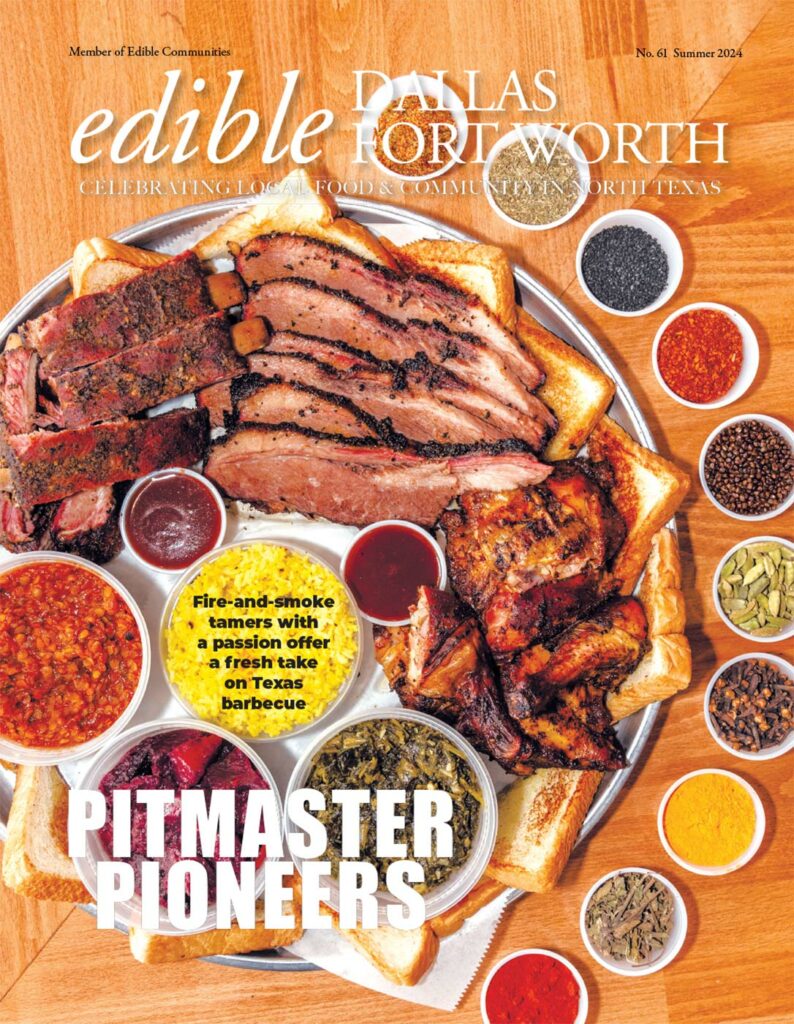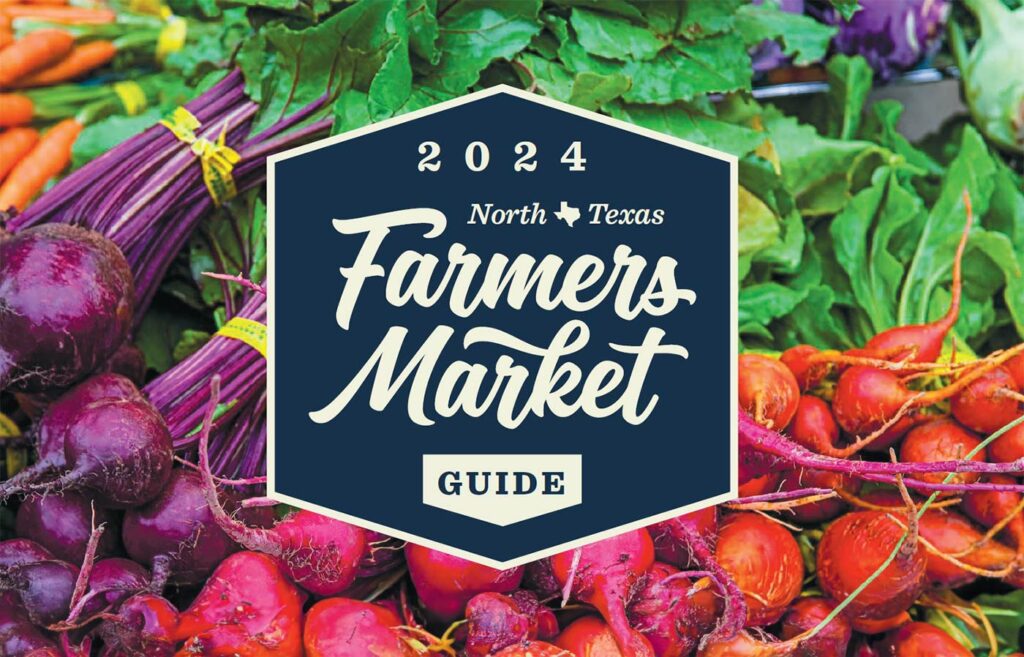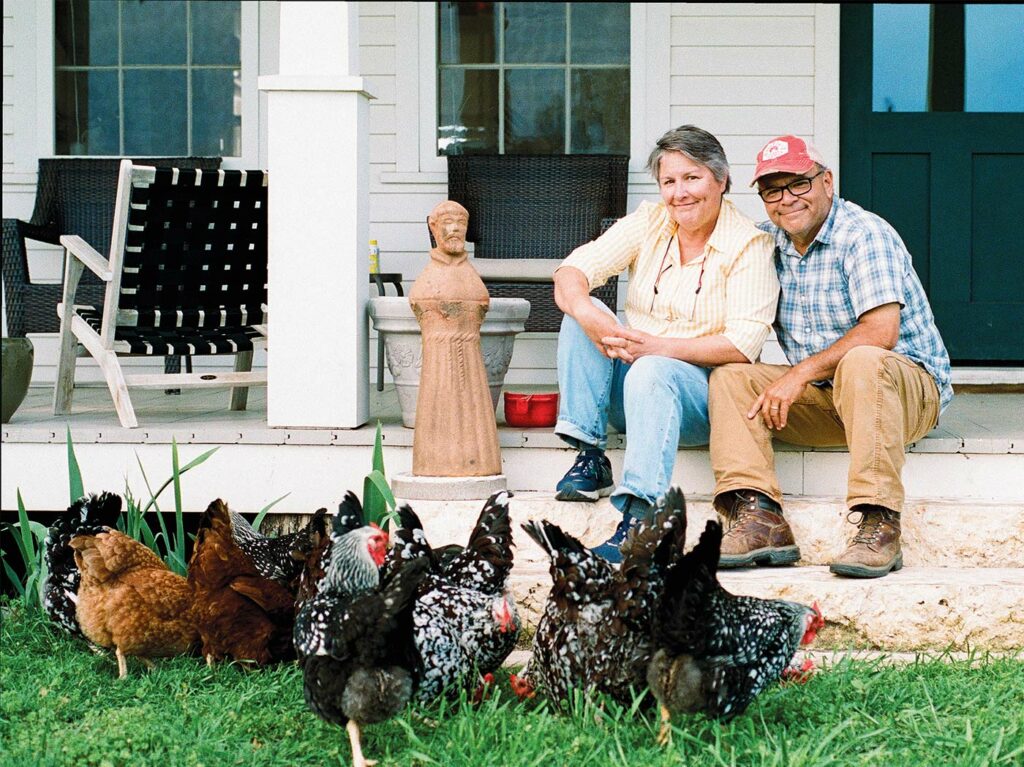
A LABOR-OF-LOVE RETREAT REMINDS US OF HUMANS’ ROLE IN AN ECOSYSTEM
PHOTOGRAPHY REBECCA EGGER, TARA LENNEY DESIGN
I was in need of solace when I stepped onto the land at Sister Grove Farm. It was a cold, crisp November, and my soul was recovering from a move that had flung me far away from friends. A synergy brought me to the farm, tucked on a patch of Blackland Prairie in Van Alstyne, where a friend was holding a family reunion in the guest houses. After one day, I saw that solace was easy to find here.
Owners Sarah and Rodney Macias were likewise smitten when they bought the land in 2016. Sarah grew up on a farm in Plano, slowly seeing the environment around her fill with concrete. Her father was passionate about water and soil conservation. She spent years working in park and natural resource management and attended two theology schools, earning a Master of Divinity degree and pursuing eco-theology. Rodney studied agricultural production and is a Master Gardener, Master Naturalist, Licensed Permaculturist and an amateur astronomer—“and Renaissance man,” Sarah breaks in to tell me. They have created a retreat where the mission is vast and reaches far beyond the clods of earth and clumps of native grasses. The first thing they will tell you is the watershed’s name. We are treading the Lavon watershed of the Trinity River on this 149-acre stretch of former Wichita tribal land, with its remodeled 1859 farmhouse and spreading elm tree that is the largest in Texas. Fueled by a desire for symbiosis, the Maciases allow themselves to be part of the layers of the land and its ecosystems.
The couple was living in New Jersey as Sarah attended theology school when she received an email from her sister. Two of her sisters—historians at heart as their mother was—had gone for a drive in the countryside on a lark, having learned that the land that had belonged to Younger Scott McKinney, the son of Collin McKinney, oldest signer of the Texas Declaration of Independence, was for sale. They fell in love with it and they also knew Sarah was looking for a place where everyone in the family could gather.
“People ask us how we found the farm, but we always say, it really kind of found us,” Sarah says. Once they’d walked the land, with its farmhouse built by hand and its spring-fed pond and pastures, Sarah and Rodney knew it was to be home. They could feel it:
“It felt like a place that needed, wanted to be shared,” Sarah says.
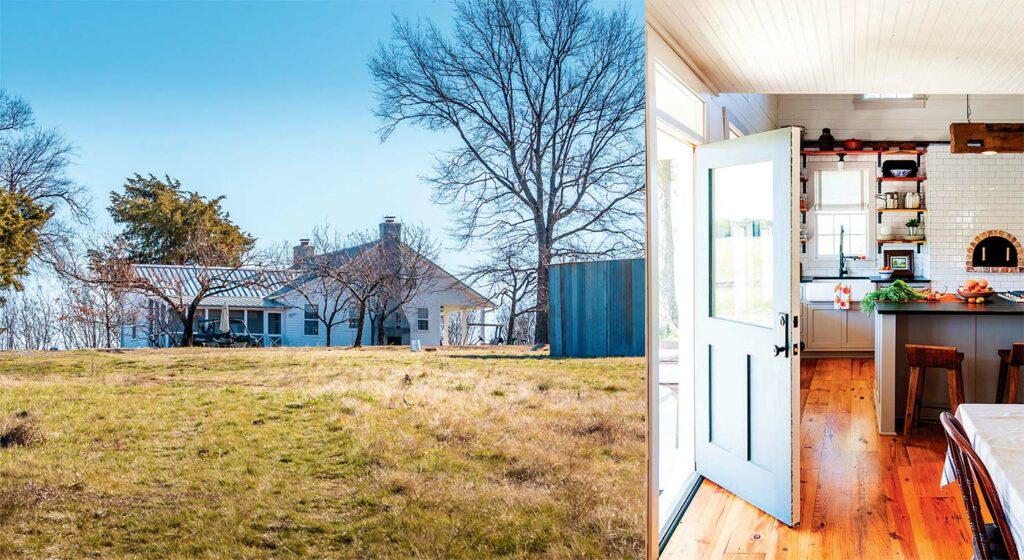
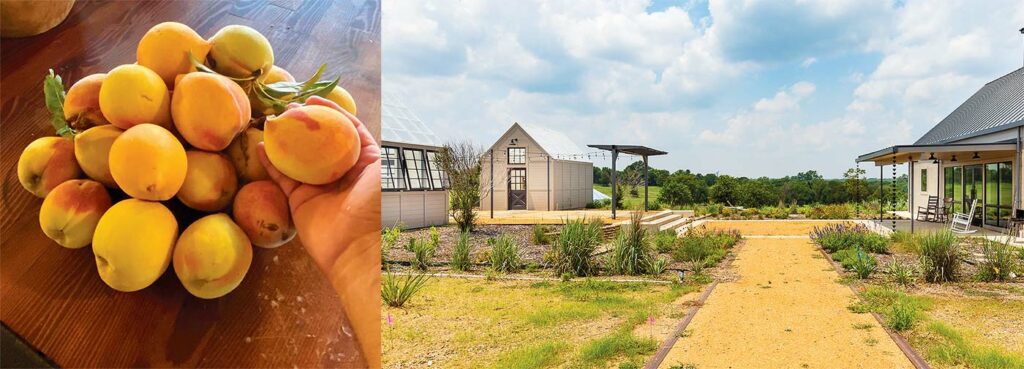
All the skills and experiences they brought to the table, “this space seems to provide opportunities for those to intertwine,” she adds. “It’s very satisfying.” John Allender of the rm Architexas, which specializes in historic preservation and has tackled projects from Fair Park to the Joule Hotel, from the Cathedral Santuario de Guadalupe in downtown Dallas to the UT Main Building tower in Austin, helped the Maciases spruce up and preserve their farmhouse. He also added a cluster of new buildings— comfortable bunkhouses to hold 36 members of the family or guests, a pavilion with a kitchen as a “mess hall,” and greenhouses— that blend into the landscape of slight hills and dips and boast views of the pond and pastures beyond.
But it’s the stewardship of the land that comes first. The goal was to rebuild a whole ecosystem from the ground up, using regenerative agriculture practices that were new to the Maciases. They’re approaching their stewardship holistically, from sowing native grasses to employing no-till farming and husbanding the livestock and chickens that contribute to a regenerative microbiome. They also intend to give people space to learn what the land can mean to them. Space where they can disconnect and reconnect with nature.
The Maciases like to quote the environmental poet Wendell Berry: “Do unto those downstream as you would have those upstream do unto you.” You glean from that imperative their sense of responsibility, which undergirds Sister Grove Farm—a communal responsibility that goes beyond sustainability to a notion of those impacted by every act. The Maciases may live in the midst of history, yet they sit lightly on the earth.
On the land, you see South Poll cattle, a breed the Maciases chose because they are smaller—and therefore more efficient as grazers—do well in the heat thanks to their light coats, and are known for their docility and mothering. South Polls are also well-adapted to a grass diet, and “we’re intent on raising grass-fed animals,” Sarah says.
“Because we went with South Poll cattle, we were surprised to see how many in North Texas also raise the breed,” Rodney says. “We used to have a monthly call group with about 15 farmers about what issues you were having.” At a dinner in McKinney, a man across from Sarah turned out to raise South Polls. “We’ve become fast friends,” Sarah says. “Those cooperative relationships,” she says, are vital. “You can’t do it on your own. It’s all about community.”
Likewise, the Hampshire sheep they’re raising for meat came on the recommendation of friend and fellow rancher Nelson Cartermere. And they limited the number of chickens in their two mobile chicken coop. They each house 25, whereas a 50-chicken mobile coop would require a truck larger than their small pickup to haul, thus compacting the land. More chickens are welcome, but the land comes first.
“It’s all about the soil,” Sarah says. “What are we doing? We’re growing grass. Well, actually, we’re growing microbes. So if you can look at your cows and chickens and sheep not as animals, not as products, but as coworkers. They can do what I can’t do; I can do what they can’t do. But if they are grazed in such a way, not as a linear engineering project, but as an ecosystem, what are the mutually beneficial relationships that are unique to that ruminant animal and the grasses?”
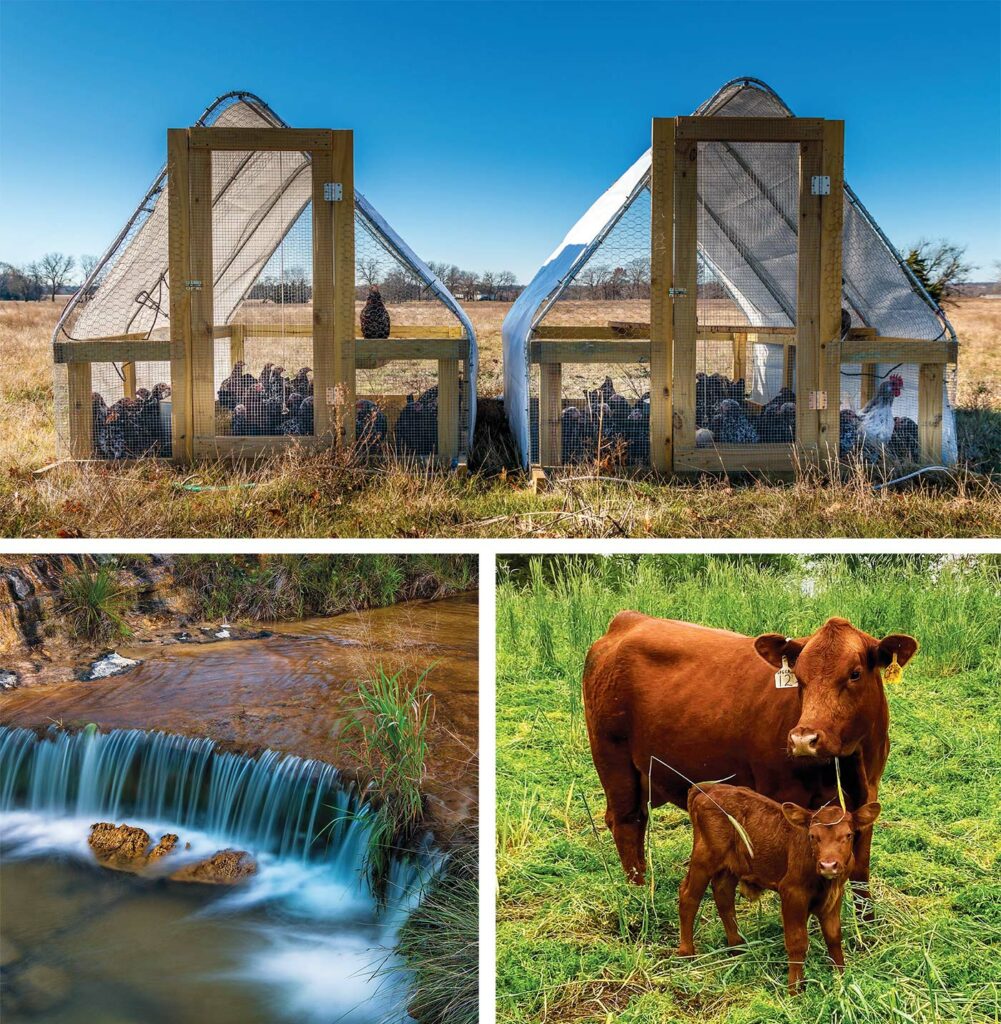
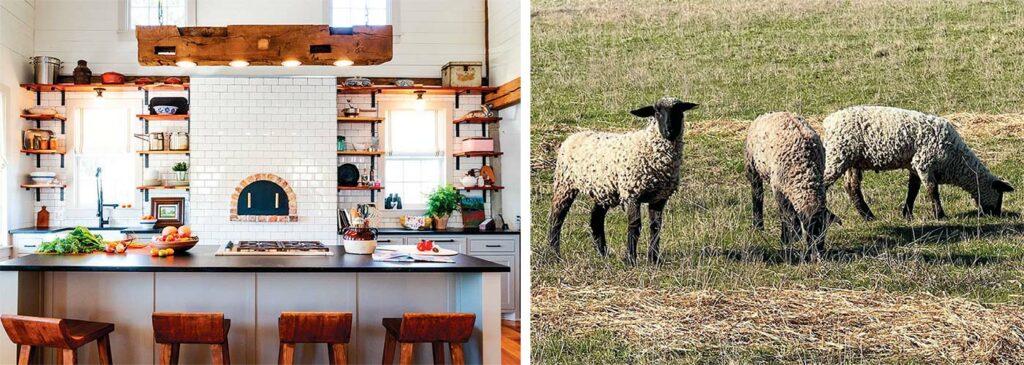
Holistic planned grazing, a cornerstone of regenerative agriculture, creates such an ecosystem. “It’s not just cattle, but sheep and cattle,” Sarah says. “Because the cattle are eating different things than the sheep. And the chickens are coming behind.” And then the earth is allowed to rest. “So that when those animals come back on that patch of earth, the roots may be deeper, the pasture may be more diverse.”
The native grasses that swayed before a plough ever touched the earth have a very deep seed profile. But with the hoof action and natural fertilizers contributed by the animals, “even the seed bed very deep in the earth can be liberated. So you see hints of the big bluestem and the little bluestem,” Sarah says, calling out the prairie grasses by name. “So it’s not one pasture of all coastal Bermuda. You don’t want a monocrop of anything.”
“We think of the earth or the environment as something out there,” Sarah adds, whereas our relationship is far more intimate. The prairie is a teacher, and its lessons are in resiliency, diversity, and the beauty of a polyculture of perennial species.
As the grasses began to express themselves, the Maciases saw change in the type of wildlife and varieties of birds they observe, like the painted bunting, which has been showing up more, Rodney tells me.
“We have a lot of depleted land in our country. But it can be brought back to life with this kind of grazing,” Sarah urges. And as a reminder: “It can’t be regenerative without grazing animals.”
Another writer whom Sarah quotes is Robin Wall Kimmerer, who, in Braiding Sweetgrass, writes poetically about sweetgrass: “Breathe in its scent and you start to remember things you didn’t know you’d forgotten.” Such connection is what the Maciases are looking for.
They hope guests feel that way when they step onto the land. Maybe folks come to attend a winter solstice ceremony, with its ushering in of the light in the darkest part of the year, or maybe they and their friends get out of the city with its frenetic pace.
“It can be as simple as come out here and take a walk and just take a breath. But that translates ecologically,” Rodney says. “We are trying to pay attention ourselves to that transformative potential. We’re learning right along with everyone.”
Because, Sarah says, “We’re the temporary custodians of this place right now,” a role taken up with humility and the desire to caretake. “That’s really an agrarian perspective we’ve become disconnected from.”
And most importantly, they hope their own journey can be useful. “The story that we’re trying to tell others is how we’re getting to know this place. A relationship with a place and all the layers that make up that place comes alive and there develops an affection. And yes this is a special place, but the place where you are is special. All places are special,” Sarah says.
Once, that is, you connect with the watershed, the earth, the animals. “Unearth the archeological layers of the soil beneath your feet,” Sarah says. “Who lived there before you, and how was it for them when they were here? Where there has been joy before you arrived, how can you learn from it? Where there has been pain, how can you redeem it?”
Sarah recalls a childhood memory from the days when she and her father walked the fields around their house: “He would stop, crouch down, and gently scoop a handful of soil. I stopped as he studied it, smelled it, felt its texture, then sifted it through his fingers back to the ground. There was a reverence. I now think of it as a prayer.”
To reserve, send a message through the Sister Grove Farm FB page or email [email protected].
EVE HILL-AGNUS teaches English and journalism and is a freelance writer based in Dallas. She earned degrees in English and Education from Stanford University. Her work has appeared in the Dallas Morning News, D Magazine, and the journal Food, Culture & Society. She remains a contributing Food & Wine columnist for the Los Altos Town Crier, the Bay-Area newspaper where she stumbled into journalism by writing food articles during grad school. Her French-American background and childhood spent in France fuel her enduring love for French food and its history. She is also obsessed with goats and cheese.




